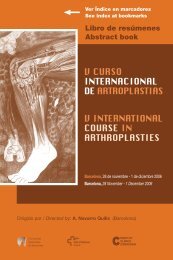Notas / Notes - Active Congress.......
Notas / Notes - Active Congress.......
Notas / Notes - Active Congress.......
You also want an ePaper? Increase the reach of your titles
YUMPU automatically turns print PDFs into web optimized ePapers that Google loves.
MIÉRCOLES / WEDNESDAY<br />
90<br />
a loose fracture reduction, followed by final cerclage cable<br />
tightening, and proximal reaming and implantation.<br />
Between 1998 and 2006, 3 orthopaedic surgeons at 3 institutions<br />
revised 20 total hip arthroplasties with periprosthetic<br />
fractures using this particular femoral component design. All<br />
fractures occurred as a result of minor trauma, such as a fall<br />
to the floor, or spontaneous fracture. No trochanteric osteotomies<br />
were performed. Allograft struts were utilized in 11 (55.0%)<br />
cases. The study population was comprised of 15 (75.0%)<br />
females and 5 (25.0%) males, with a mean age of 75.4 years<br />
(range, 43.6 – 87.5) and a mean BMI of 26.9 (range, 17.0-<br />
35.6). Vancouver fracture classification distribution was as<br />
follows: 2 (10.0%) B1; 3 (15.0%) B2; 14 (70.0%) B3; and 1<br />
(5.0%) C. Mean follow-up was 3.6 years (range, 1.1 – 7.5).<br />
The mean Harris Hip Score at the most recent follow-up was<br />
84.6 (range, 65.0 – 100.0) and the mean pain sub-score of<br />
39.2 (range, 30.0 – 44.0), corresponding to good clinical results<br />
with mild to no pain. The majority (70.0%) of patients<br />
exhibited Brooker I heterotopic ossification. Eighteen (90.0%)<br />
patients had no subsidence. Subsidence of 2- and 6-mm<br />
occurred in 2 (10.0%) cases with stable and integrated femoral<br />
components. Distal portions of all fractures healed; however,<br />
2 (10.0%) fractures with proximal splitting of the femur became<br />
trochanteric nonunions in distally well-fixed stems. One (5.0%)<br />
patient experienced a dislocation approximately 3 months<br />
postoperatively, which was successfully treated with a closed<br />
reduction. No revisions have occurred. These promising shortto<br />
mid-term results, with minimal complications and no revisions,<br />
suggest that this specific cementless, modular, corundumized,<br />
tapered femoral component is a viable management<br />
option for complex periprosthetic hip fractures.<br />
Distal fixation was achieved in all cases despite the complexity<br />
of the fractures, with the majority occurring at or just below<br />
the stem in patients with poor proximal femoral bone stock<br />
CAMBIOS ÓSEOS TRAS LA UTILIZACIÓN<br />
DE VÁSTAGOS LARGOS EN CIRUGÍA<br />
DE REVISIÓN<br />
Eduardo García Cimbrelo<br />
Hospital La Paz, Madrid (Spain)<br />
El aflojamiento del componente femoral produce frecuentemente<br />
graves defectos óseos que hacen difícil la cirugía<br />
de revisión. La revisión quirúrgica mediante vástagos cementados<br />
y vástagos no cementados con poro proximal ha<br />
demostrado resultados dudosos en pacientes con defectos<br />
óseos. La técnica de injerto impactado, si bien ha permitido<br />
obtener buenos resultados, es una técnica difícil y no exenta<br />
de complicaciones. 1,2 Wagner desarrolló un vástago recto<br />
no cementado de permitía una buena fijación diafisaria distal<br />
al defecto óseo preexistente, observando excelentes resultados<br />
clínicos e incluso una regeneración ósea de dichos<br />
defectos. 3 A pesar de estos buenos resultados, fueron<br />
frecuentes las luxaciones y lo hundimientos del implante 4-6<br />
En una serie de 79 vástagos Wagner SL (Sulzer, Zimmer<br />
Win-terthur, Switzerland) utilizados en cirugía de revisión<br />
con un mínimo de 5 años de seguimiento, 6 hubo 11 luxaciones<br />
pero sólo un vástago aflojado y relacionado con un mal relleno<br />
del canal. La probabilidad acumulada de no tener una<br />
revisión del vástago por cualquier causa fue 92.3% (86.8%-<br />
97.8%) en el mejor escenario posible. Se observó regeneración<br />
ósea proximal definida en 50 caderas pero fue asociada<br />
a ausencia de defectos mayores (p=0.01). En conjunto, se<br />
pudo encontrar un aumento de las corticales lateral y medial<br />
al final del seguimiento (p10mm (8 caderas)<br />
se relacionó con un pobre relleno del canal (p=0.003).<br />
La osteoporosis preoperatoria según los grados de Moreland<br />
7 determinó el “stress shielding” postoperatorio. Un grave<br />
“stress shielding” se observó en 5 caderas en los que incluso<br />
desapareció parte de la cortical lateral proximal. El grosor<br />
de la cortical medial aumentó una media de 15% con el paso<br />
del tiempo (p





